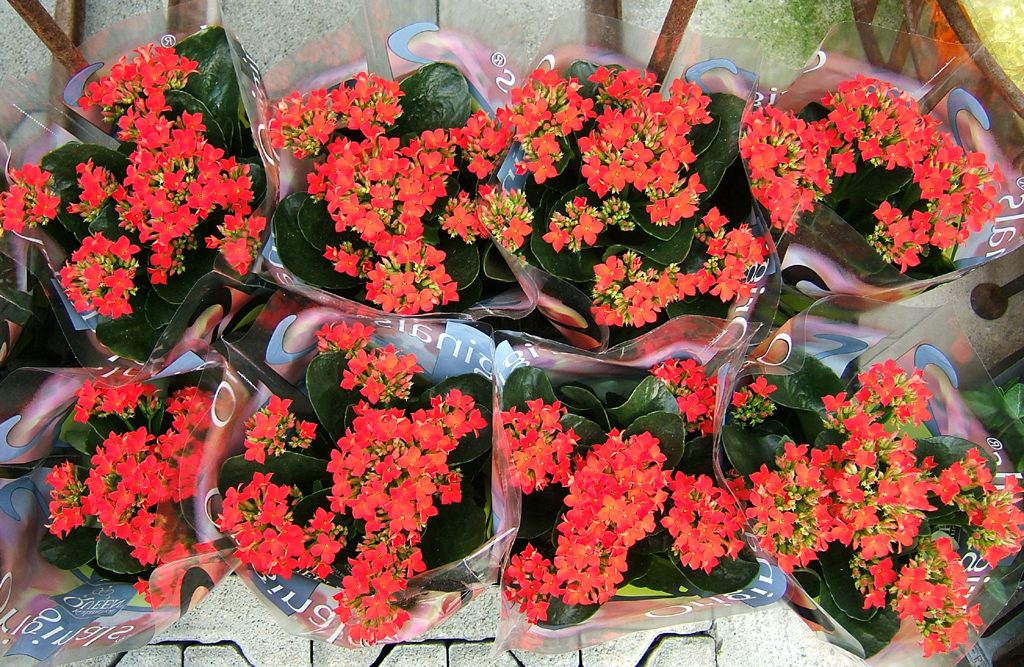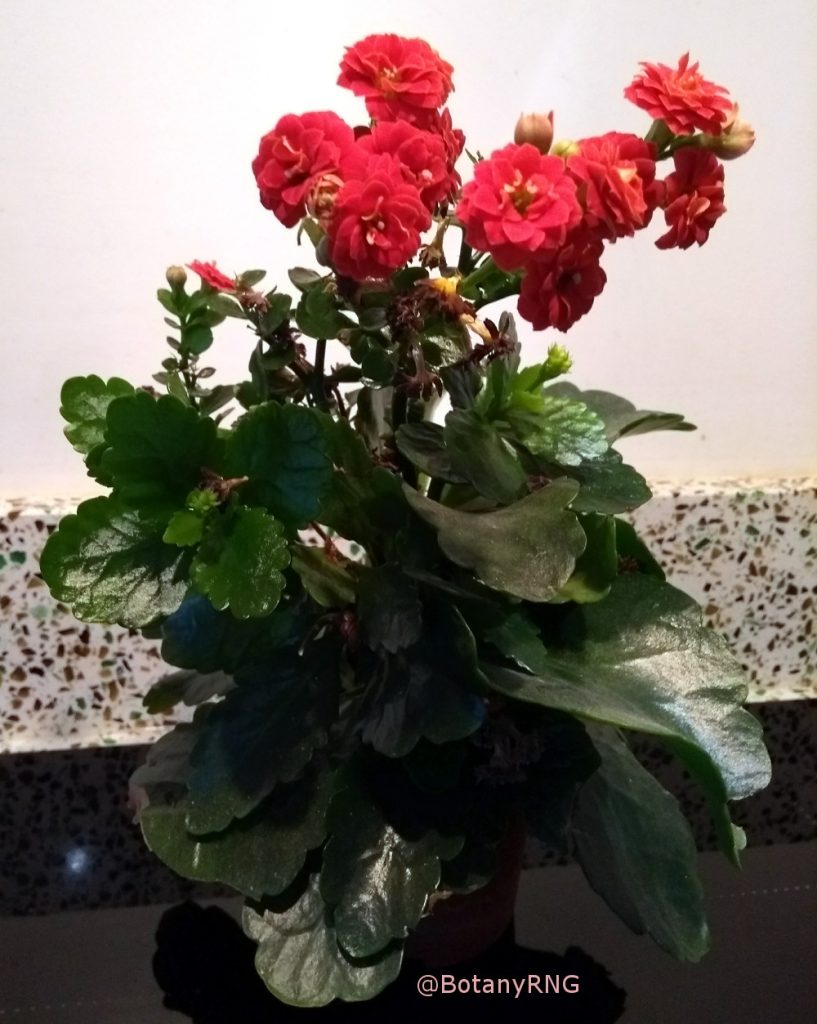By Will Simpson

Most Kalanchoes, including K. blossfeldiana, are native to Madagascar. Only a few of over 100 species are regularly seen in cultivation. These are popular for their interesting foliage and for the ease with which they can be grown. The leaves of K. blossfeldiana are simple, fleshy, glabrous and shiny, with crenate margins, an oblong shape and opposite arrangement. They are relatively uninspiring, however, but this is of little importance as K. blossfeldiana is valued mainly for its flowers.
Time to Flower

wikimedia commons
Two other popular houseplants that include ‘Christmas’ in their common names have featured in previous Advent Botany blogs; the Christmas cactus and the Christmas Star or Poinsettia. All three are staples of the holiday and florist trade1 having been bred to provide colour in homes at a time when outdoors nature is thought to be at it’s greyest.

Commercial success
K. blossfeldiana’s specific epithet honours Robert Blossfeld (1882-1945), the German botanist and nurseryman who saw the commercial potential of the species and introduced it to the rest of the world in 1932(2). Ironically, for a man responsible for the introduction of a now common houseplant, ‘bloss feld’ literally translates as ‘merely field’.
The original colours of the Christmas Kalanchoe were orange and red and it was not well adapted as a houseplant as it grew rather tall and loosely. Because of this, it wasn’t until the 1980’s that the plant made it’s true international breakthrough.

Originally all kalanchoes had four-petaled flowers. Then in 1998, a Swedish retailer found an individual in with a lot of plants that, rather than 4, had 32 petals, forming a small rose. This mutation was launched as a cultivar under the name ‘Leonardo’. After a major hybridizing program, a new series of fully double kalanchoes was launched in 2002 under the name of Calandiva®(4).
Is a Kalanchoe for life or just for Christmas?
Many people feel that the Christmas Kalanchoe is attractive only in its first year and so, like bulbs which are also popular Christmas presents, they are often discarded after flowering.

It is easy for new plants to be propagated by taking cuttings of old ones – whether the old ones are discarded or not – and many of the hundreds of online plant-care pages for K. blossfeldiana suggest doing this, rather than keeping the original plant(5).
From my own experience of growing the Christmas Kalanchoe, although easy to propagate from cuttings, I’ve found it difficult to even to get new plants to flower again satisfactorily. Indeed, it is hard to strike a balance between providing sufficient hours of light to enhance overall growth and sufficient hours of darkness to promote flower production; too much light reduces reduces blooming and too much darkness leads to ‘leggy’ and unstable plants. From numerous cuttings, very seldom does one end up with an attractive-looking plant and never are they how they looked when originally purchased.

In researching this blog online, two points have given me food for thought. The first is to do with the need for plants to be in flower at the time at which they are given as presents. I understand people want to show the plant they are giving at the height of its beauty, but this can only lead to disappointment when flowering is over. As is the case with the Christmas Kalanchoe, the plant may never flower as well again. Why not just go for plants that are attractive regardless of their floral display but still have the potential to flower? With such plants the anticipation of flowering can be as rewarding as experiencing the flowers themselves. This greater potential to please is best demonstrated when a plant thought unlikely to flower at all surprisingly does.
Secondly, I was somewhat taken aback when reading plant care advice such as, “pick any color that appeals to you and just replace the plants when they become unattractive”6. This is just what suppliers hope consumers will do in order for them to buy more, but unfortunately it is also the way many people treat plants. Such a conflict between ethics and aesthetics is perhaps symptomatic of today’s consumer society and a form of plant blindness, where “plants – living things – often become throwaway items used purely for decoration, with little acknowledgment given to their much deeper importance to the human state”(7).
My thinking is that, besides decoration, the point of a houseplant is to bring life into our homes and if a plant is not sufficiently appreciated to be cared for when not in flower, then perhaps it ought not to be kept at all, let alone be bought to give as a present. I am starting to wonder whether or not the Christmas Kalanchoe is such a plant.
[1] Iannotti, M. (2017) Top 8 Easy Care Flowering Houseplants https://www.thespruce.com/the-best-flowering-houseplants-1402664 (Accessed 12/12/2017)
[2] A world traveller in your own back garden (n.d.) http://www.kalanchoe.nl/en/kalanchoe/ (Accessed 16/12/17)
[3] Care of the Kalanchoe Plant (2005) http://www.krismers.com/Kalanchoe_care.pdf (Accessed 16/12/17)
[4] Double the Fun with Calandiva Kalanchoes (2014) https://laidbackgardener.blog/tag/kalanchoe-blossfeldiana/ (Accessed 16/12/17)
[5] Eng, D. (2010) The Unscripted Mind – How To Care For Christmas Kalanchoe http://unscriptedmind.com/how-to-care-for-christmas-kalanchoe (Accessed 16/12/17)
[6] Kalanchoe plant (n.d.) http://www.botanical-journeys-plant-guides.com/kalanchoe-plant.html (Accessed 12/12/17)
[7] Blackhall-Miles, R. (2015) We need a cure for plant blindness https://www.theguardian.com/lifeandstyle/gardening-blog/2015/sep/17/we-need-a-cure-for-plant-blindness (Accessed 14/12/2017)
Editor’s note
I’m pleased to say that my red double-flowered Kalanchoe is flowering well a year after it was given to me. It’s not yet been repotted and it lives on a windowsill getting watered only when dry.

